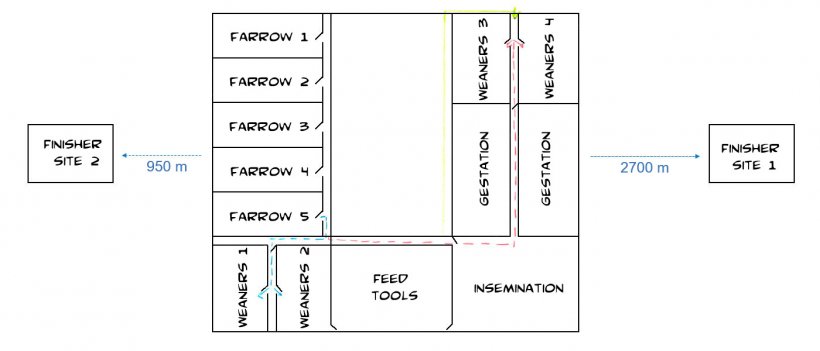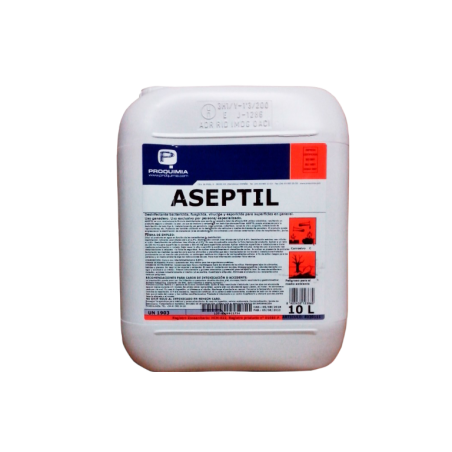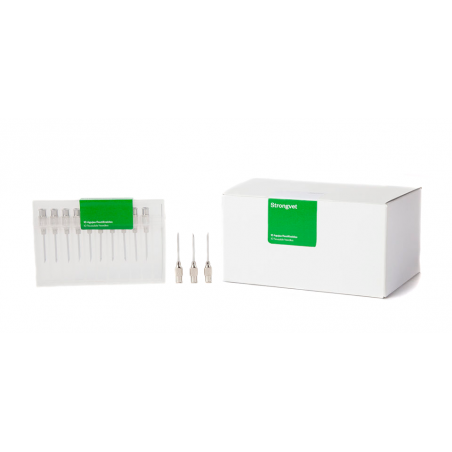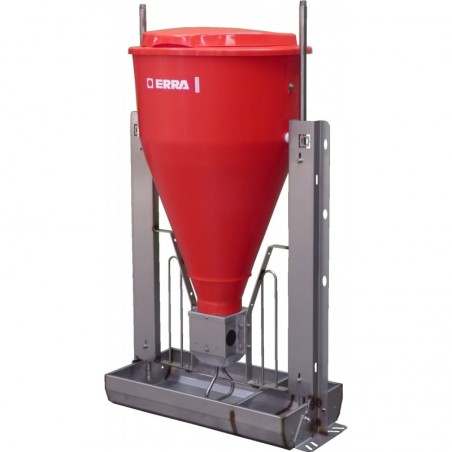There is a variety of PRRSV programs in place for the control of PRRSV in different herds, but the preferred strategy for most herds is to establish a stabile sow herd where the sow are immunized/exposed prior to introduction into the sow herd and the piglets are PRRS virus free at weaning.
The aim of this paper is to give some inspiration to herd supervisors on how PRRSV eradication/control plans can be implemented in a given herd with focus on the planning process, which, in our opinion, is the key to success.

Handling of PRRSV positive herds
In case of an acute clinical outbreak of PRRS in a negative sow herd or in the case where you confirm that the herd is unstable, the initially aim is to stabilize the herd. The first step is to vaccinate all sows with modified live virus (MLV) vaccines two times, spanned by four weeks as soon as the virus has been typed (PRRS-1 or PRRS-2). In a typically acute outbreak, the greatest clinical impact is seen during the first four weeks, which is also the time between the two mass vaccinations are performed. This period is used to elaborate the further plan with the owner. At this stage, no management restrictions are made in the different parts of the production, because the experience is that there is so much virus circulating that change in routines doesn´t make a big difference. Thus, if restrictions are implemented at this stage without any impact, the perception of the employees would be that changes do not help and they get frustrated and de-motivated which will be counter-productive, when the real work with management changes starts after the four weeks.
The further process are divided into four main steps:
Step 1. Evaluation of the current health status and identification of the goal
The first step is to identify the overall goal: PRRS control or PRRS elimination? Before that decision can be made, knowledge about the following issues must be taken into consideration:
- Why/how did (re)infection happen?
- Herd structure
- Capabilities and limitations of the production system and geographical area
- Motivation/involvement of the employees
- Economy
It is important to know how the herd was infected in the first place, to make the right strategy for the future. All relevant information are described in a report, which not always will give a definite answer, but the process of evaluation will most often identify issues of high risk.
The report typically contains information about the following issues:
- Air (geographical placing of the herd, knowledge about the current PRRS-status at other farms in the same area)
- Swine movements (entry of replacement stock, removal of sows for culling, weaned pig removal, disposal of dead pigs)
- Entry of semen
- People movements (employees, visitors, etc.)
- Vehicles/deliveries (feed, supplies, etc.)
- Employees:
- Are they motivated to follow a new schedule (especially important for employees in the farrowing area)?
- Are they able to understand the strategy?
- How do we ensure that they follow instructions in the daily work?
Employees are a very important part of every program, as they are the ones that are going to work with the strategy daily. A major challenge is that 80-90% of all employees in Danish pig productions are from Eastern Europe and they have poor language skills. This is a major complication for PRRS elimination plans to be successful.
Finally, the cost associated with the program should also be considered, but compared to the costs of having an unstable herd, all PRRS elimination programs have a beneficial cost/benefit ratio. If choosing the Load Close and Homogenize (LCH) model, the herd is loaded with replacement stock, which demands that immediate liquidity is available, but the total expense would typically be less, because gilts in average are younger at the time of purchase. There will be limited costs for purchase of vaccines.
Having this information, the farmer and the veterinarian can make a decision, whether the strategy should be to make plans for a seropositive sow herd, making it possible to wean seronegative pigs or the goal should be elimination of virus.
Step 2. Planning the program
No production system is the same, which is also why a specific program is required for each herd.
Making a sketch drawing of the facilities is the first step. If the system involves more than one site, all the sites are put on the same page of paper. This gives the opportunity to add arrows indication pig flow within the systems, but also between the sites. The drawing will also contain information about the sizes of the sites, the distance between them, other swine farms in the area and their PRRS-status.

The program is visualized in a calendar, as it gives the best overview for the farmer, employees, and the veterinarian. The calendar should only contain the most important events and could look like this:
| Project week | Action |
|---|---|
| 0 | Vaccination; introduction of gilts |
| 4 | Vaccination |
| 16 | Processing fluids PCR |
| 17 | Processing fluids PCR |
| 18 | Processing fluids PCR |
| 19 | Processing fluids PCR |
| 28 | Pigs weaned for 2-3 weeks -PCR |
| 29 | Pigs weaned for 2-3 weeks - PCR |
| 30 | Pigs weaned for 2-3 weeks - PCR |
| 31 | Pigs weaned for 2-3 weeks - PCR |
| 33-40 | introduction of seronegative gilts |
| 44-46 | Serology on sentinels |
The calendar has information about introduction of gilts, vaccinations, and testing procedures. The next step is to write down the management procedures:
Acclimatization of gilts:
- Plan the next introduction of gilts:
- At least 12 weeks in a acclimatization site
- MLV-vaccine or not (depending on the strategy and outcome of tests)
Biosecurity:
- Wash with soap and disinfect all aisles and sections before putting in a new group
- Heat and dry out
- One set of tools for each section
- Change footwear when walking from one farrowing section to the other
- Wash and disinfect hands between section
People flow:
- The sketch drawing can be useful to get a hold of people flow
- Add people movement to the drawing, using different colors to indicate which movements, that are allowed. Also put in the wrong movements to point out the importance!
Pig flow:
- Use another sketch drawing of the system, to get a hold of pig flow in the system.
- Arrows in different colors can indicate the flow of piglets, sows, weaners etc.
- Correct wrong flows and make a new drawing to use when teaching farm staff
McRebel:
- Implement the McRebel management recommendations
- In case of many liveborn pigs modify the recommendations about foster sows to reduce pig mortality
- Change needles between each litter
- Use disinfectant for knives and other tools
- Tail-docking should be done without the presence of blood
- Eventual teeth-grinding
Step 3. Implementing the strategy
The stabilization/elimination plan is discussed and adjusted in dialog with the owner/manager and then shared with the rest of the staff. It is important that all individuals, that are involved, are participating in this meeting. Vaccinations, management changes, gilt recruitment and timelines are listed in the calendar, which should be accessible for all employees.
The key to success is proper implementation of the strategy. This is a period with great uncertainty as the owner and staff are insecure and afraid of making mistakes, so it is important to visit the farm often. Monitoring by sampling will over the following weeks will show whether the guidelines are followed, but in the beginning of the elimination period, the best monitoring will be your presence in the herd.
The experience is, that employees will do a better job, if you not only tell them to change specific procedures, but also explain why it is important. Minimizing transmission routes is important for the completion of the elimination/control strategy. Teaching the staff about this topic should be included when presenting the plan. The use of pictures and drawings make it more interesting and contribute to overcome the language barrier.
However, communicating about the plan is an ongoing process, so questions and following up, is to be expected, particularly during the first couple of months.
Step 4. Program monitoring and evaluation
Monitoring the program consists of three components:
- Making sure that that the full program is being implemented as planned
- Monitoring the effect of the program on productivity and clinical symptoms
- Monitoring the effect of the program on objective parameters such as serology/PCR
Control that the program is implemented as expected, puts up demands for the veterinarian to spend more time in the herd:
- watching how the working procedures are being done
- observing pig and people flow
- checking cleaning and biosecurity in general
- talking to farm staff and continuously reminding them about the agreements
- watching the mixing of MLV-vaccines, using correct dosage
- correct storage of vaccines
Within a few weeks the effect of the program should be recognizable through clinical observations and objective measures of productivity. Make weekly data-collection based on the following:
- No. of live born and still born pigs/litter
- No. of death pigs in farrowing sections
- Weaning weight
- Farrowing rate
Baseline production should be obtainable within 22-23 weeks after the initial (re-) infection.
Finally, the clinical observations and data collections should be supplemented with diagnostic information as described in the testing protocol in the elimination plan. When sentinels test negative, total eradication is completed. Probably it is possible to wean negative pigs at an earlier stage, but do never compromise on the duration of herd closure! Stick to the plan – also even if the diagnostics from young animals are negative at an unexpected early stage. The virus may persist in a very small proportion of the animals.
Example of a successful program ![]()
Concluding remarks
The three most important things in respect to a PRRSV control program are: 1) planning; 2) planning and 3) planning; and the success of the program depends also on three important factors: 1) people; 2) people and 3) people! PRRSV control is less about science and more about management, proper pig flow and patience. If you find that the staff are insufficiently motivated and the structure of the herd prevent proper flow of pigs and insufficient internal biosecurity then do not start an elimination program until these things have been changed…it’s waste of money and time.











